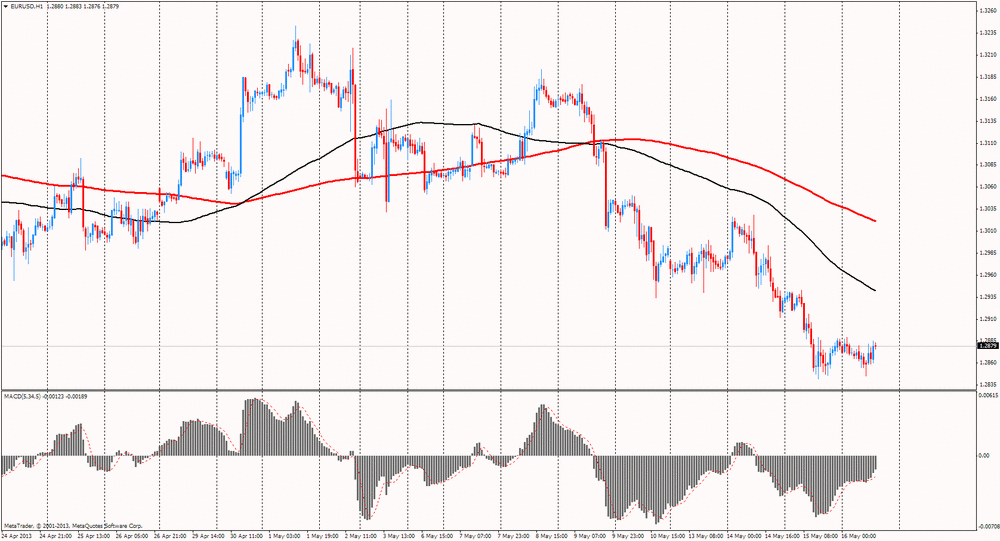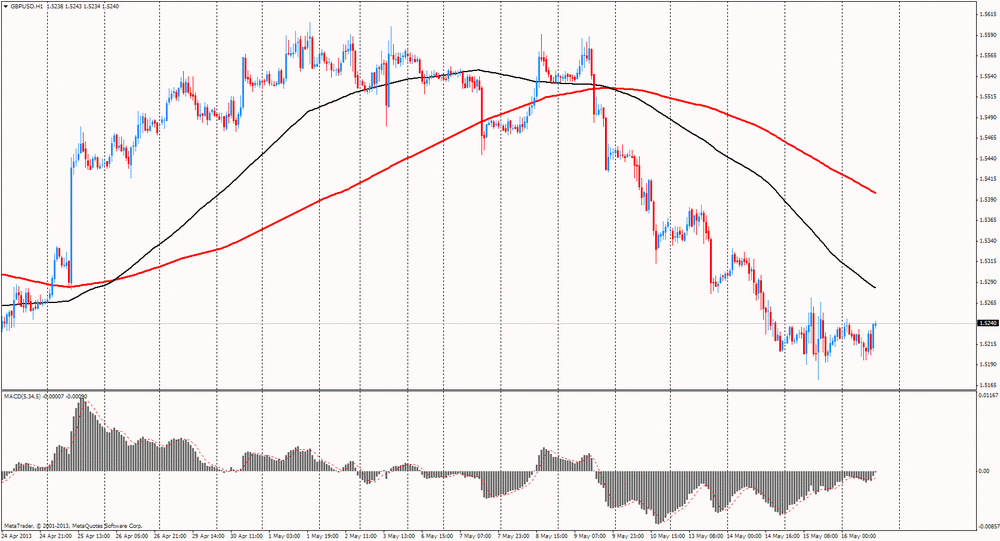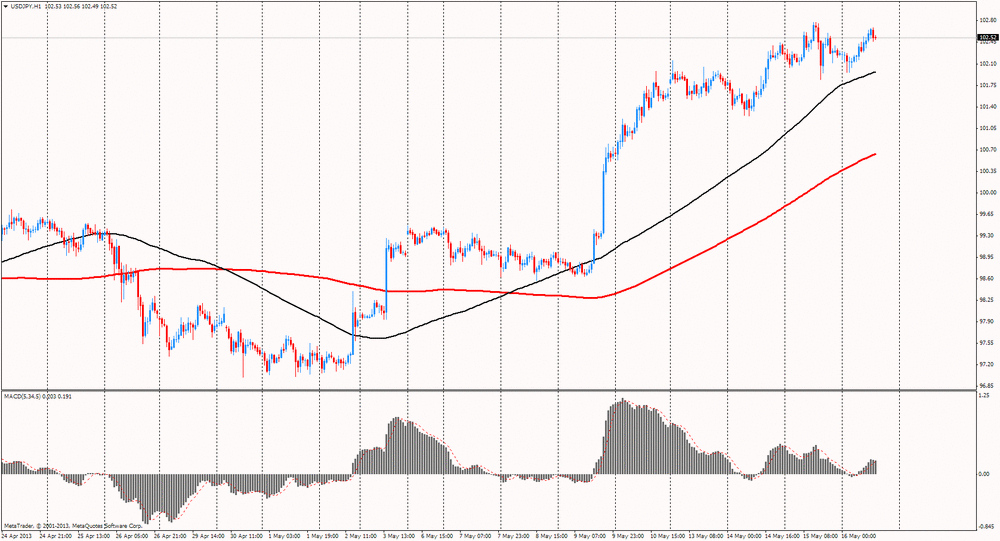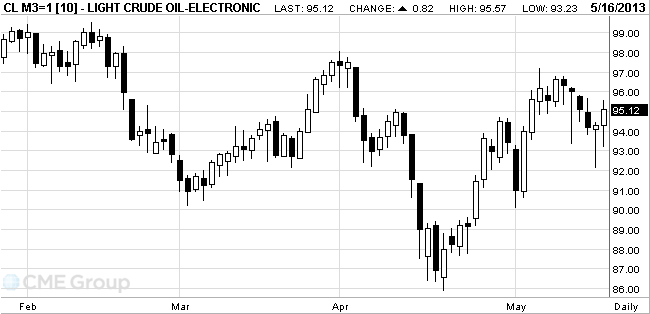Data
02:00 New Zealand Annual Budget Release 2013
04:30 Japan Industrial Production (MoM) (Finally) March +0.2% +0.2%
+0.9%
04:30 Japan Industrial Production (YoY) (Finally) March -7.3%
-6.7%
06:45 France Non-Farm Payrolls (Preliminary) Quarter I -0.3% -0.3%
-0.1%
09:00 Eurozone Trade Balance s.a. March 12.0 11.8
18.7
09:00 Eurozone Harmonized CPI April +1.2% -0.1%
-0.1%
09:00 Eurozone Harmonized CPI, Y/Y (Finally) April +1.2% +1.2%
+1.2%
09:00 Eurozone Harmonized CPI ex EFAT, Y/Y April +1.5% +1.0%
+1.1%
The euro
exchange rate fluctuates
against the dollar,
approaching the maximum values of the session. Note that the
latest data published by Statistics Eurostat, the trade surplus
Eurozone has increased markedly in March, being at the same time by
more than two times higher than in the previous month. We also add
that this was the highest value since records began in 1999, which
was due to a sharp increase in exports and decrease imports.
According to experts, the high export figures give some hope that
the eurozone may soon return to growth after a prolonged reduction,
and suggests that the decline recorded in the first quarter, was
associated with a very weak domestic demand. According to the
report, the unadjusted trade surplus rose in March to a level of
22.9 billion euros, compared with 10.1 billion euros in February.
Recall that in March 2012 the surplus was 6.9 billion euros. In
addition, it was reported that the seasonally adjusted surplus in
merchandise trade rose to the level of 18.7 billion euros, compared
with a surplus of 12.7 billion euros in the previous month, which
was revised up from 12 billion euro. According to experts, the
surplus was $ 11.8 billion. In addition, the data showed that the
volume of exports of the euro zone rose to a seasonally adjusted
2.8 per cent compared with February. At the same time, the volume
of imports fell by 1 percent. Note that a further report, which was
submitted to Eurostat showed that the annualized rate of inflation
in the euro area declined in April to 1.2 percent from 1.7 percent
in March. On a monthly basis, inflation declined to 0.1 percent, in
line with economists' forecasts. Core inflation, which excludes
prices of energy, food, alcohol and tobacco, fell to 1 percent from
1.5 percent a month earlier. In the EU27, the annual inflation rate
was 1.4 percent, down from 1.9 percent in March. The lowest rates
were observed in Greece, Latvia and Sweden, while Romania showed
the highest values.
The yen
declined significantly
against the dollar,
even though the publication of better-than-expected data. Data
released by the Japanese government show that qoq economy grew by
0.9% in the period from January to March, while year - by 3.5%,
which is the best result among the G-7. This improvement is also
the result of increasing the volume of private consumption (+0.9%
in Q1 this year) versus 0.4% in the previous quarter, as well as
personal expenses, which increased by 0.6%, slightly less than in
the last quarter of 2012. In addition, the fall of the yen to boost
exports, which marked an increase of 3.8% compared to -2.9% in the
period October-December 2012.
Experts note that the result of the monetary incentive, launched by
the Japanese Prime Minister Abe, as well as the Bank of Japan, also
known as "Abenomika" were two quarters of economic growth. They
also add that Abenomiki continued success depends on whether the
Japanese government implements the planned steps. In January, the
government announced a major expansion of the leniency program (10
trillion. Yen), the Central Bank raised its target mark on
inflation to 2%. In April, the Bank announced a doubling of the
size of the QE program to 270 bln. yen by the end of 2014, "and the
next step will be the presentation of a new strategy for growth,
planned for June.
EUR / USD: during the European session, the pair dropped to $
1.2845, but then rose $ 1.2886

GBP / USD: during the European session, the pair dropped to $
1.5195, after which rose to $ 1.5244

USD / JPY: during the European session, the pair rose to
Y102.68

At 12:30 GMT Canada is to publish data on the volume of
transactions with foreign securities in March. Also this time the
U.S. will report the volume of building permits issued and the
number of Housing Starts in April and present the consumer price
index and core consumer price index for April. At 14:00 GMT the
United States will Fed manufacturing index for May Philadelphia. At
22:45 GMT New Zealand will release the Producer Price Index and the
Producer Price Index for Q1. At 23:50 GMT Japan will report on
changes in the volume of mortgage lending in Q1 and the change in
the volume of orders for machinery and equipment in
March.




















